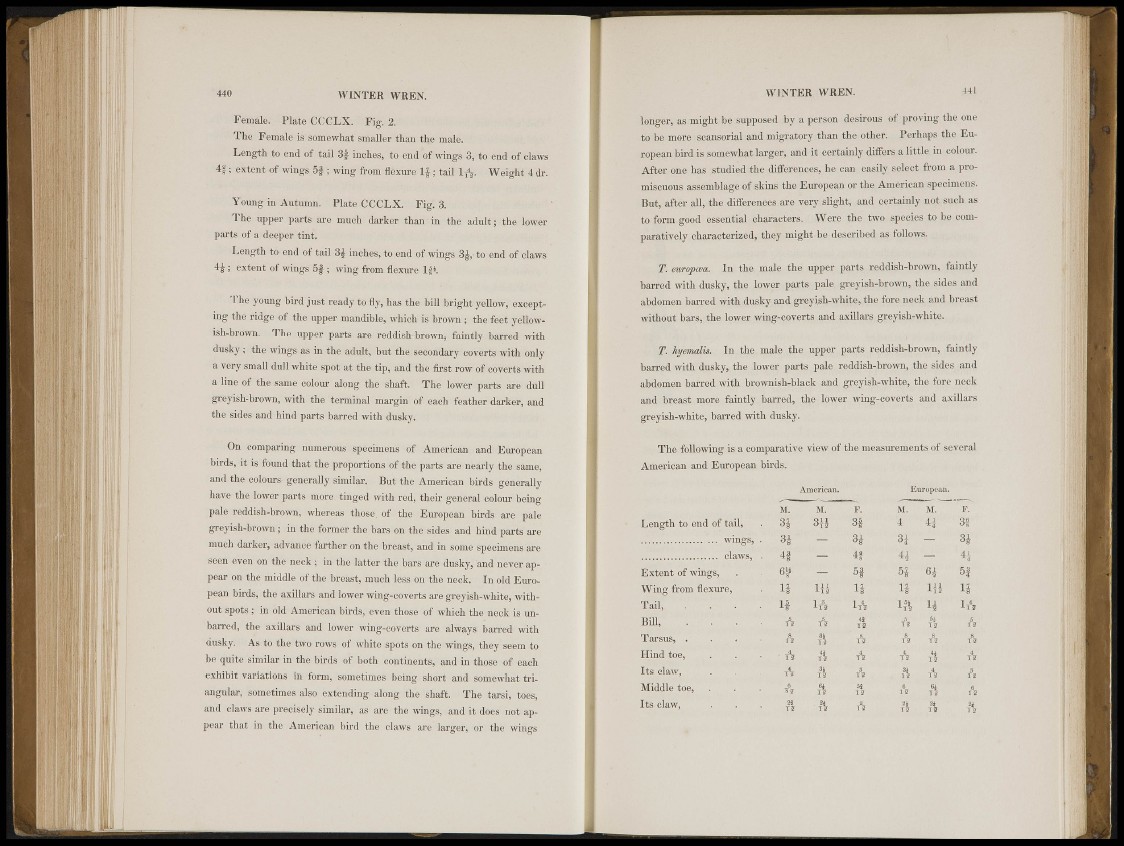
440 WINTER WREN.
Female.• • l'Iato CCCI/X. Fig. 2.
'l'ho Fumale is somewhat smaller than the malo..' ' '
I.engtli to end of tail 8f inches, to end of wingst 3, to orni ot' claws
41; extent of wings 5jf ; ivini; from flexure 1| ; tail 1,V Weight 1 dr.
Young in Autumn. Plate CCCLX. Fig. 3.
Thé tippër parts aïe much darker than ill the adult; the lower
pftrts of a deeper tint.
•Iiength to end of tail 3 | inches, to end of wings to end of claws
5 extent of wings 5§ ; wing from flexure! 1J». '
The young bird just ready to fly, has the fell bright yellow, (..toppling
the ridge of the upper mandible, which is brown ; the feet yellowish
brown. The «ifger parts are reddish-brown, faintly barred with
duskyif, the: wings as in the adult, but the secondary coverts with only
S v e r y small dull whi te spot at the tip, and the first row olfcoverts with
a line of the same colour along the shaft. The. lower parts are dull
greyish-brown, with the terminal margin of each feather darker, and
the sidos'and hind parts barred with dusky;
On comparing numerous specimens of American: and European
birds, it is found that the proportions of the parts are nearly the same,
ami the colour« generally similar. Hut the American birds generally
have the lower parts more, t l i i pd with red, their general colour beingpale
reddish-brown, whereas those of the European bird's are pale
greyish-brown ; in the former the: bars on thé sides and hini parts are
much darker, advaiiec farther on the breast, and in soin* specimens ate
seen even on the neck ;: in the latter the bars are du>ky, and never appear
on the middle of the breast, much i f i f em the neck. In old European
birds, the axillars and lower wing-coverts ¡ire greyish-white, without
spots ; il! old American birds, even those of which: the nock is unbarred,
the axillars and lower wing-coverts are always barred with
dusky: As» IÔ the two rows H white spots, on the wings, they seem to
be quite similar in the birds of both continents, and in those SB each
exhibit variations in l'orni, sometimes being short and somewhat triangular,
sometimes also extending along the shaft; The tarsi, tees;,
and claws are precisely similar, as are the wings, and it does1 not appear
thai in the. American bird the claws are larger, or the wings
WINTER WREN. 441
longer, as might be supposed by a person desirous of proving the one
to be more; sensor ial and migratory than the other. Perhaps the European
bird is somewhat larger, and it certainly differs a little in colour.
Alter one: has studied the differences, he can easily select from a promiscuous
assemblage of skins the European or the American specimens.
But, after all, the differences: are very slight, and certainly not such as
to form good essential characters. Were the two .species to be comparatively
characterized, they might-be described as follows.
T. en.ropwa. In the male the upper parts raldish-brown, faintly
barred with dusky, the lower parts pale greyish-brown, the sides and
abdomen barred wi t h dusky-and greyish-white, the fore neck and breast
without bars, the lower wing-coverts and a^illarsgreyish-white.
T. hyemdis, In the npale the: upper parts reddish-brown, faintly
barred with dusky, the lower parts pale: reddish-brown, the sides and
abdomen barred n i i l , brownish-black and greyish-white, the fore neck
and breast more faintly barred, the lower vving-covorts and axillars
greyish-white, barred with dusky.
The following is a comparative view of the measurement s of several
American and European birds.
American. "" European.
Hi, M. .. Si. - M. M.
Leiigth to end of tail, •3§ " m ' I: ' " i r 3? ;
s r — g j i l
K^-W.uf Si
— Vi-'1 •il
Extent of wings, . — 5 | t i
Wing from flexure, i Ï Uh Li I f IH n
i f ""lii" 1ft u I A
Bill, . . » • ÏJ5-I :•'. 15 r H T2 l i ''A
Ta r sus , . ' " ' J ' Si 1m.2 mX2i
Hi n d tin', . . ' ' . '1 T42 T43L 12 1H5: : ' 12
142 T32» 152 . & h A
Mi d d l e toe, ; .6 61 1 1532 1s2 189t A
I t s claw, Ï225 Ì3 Ta? TgZ I%B !